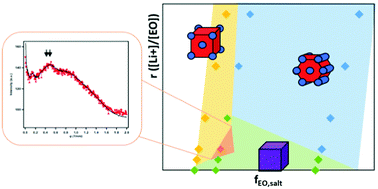Reentrant phase behavior and coexistence in asymmetric block copolymer electrolytes†
Abstract
It is known that the addition of salts to symmetric block copolymers leads to stabilization of ordered phases and an increase in domain spacing; both trends are consistent with an increase in the effective Flory–Huggins interaction parameter between the blocks, χ. In this work, we show that the addition of salt to a disordered asymmetric block copolymer first leads to the formation of coexisting ordered phases which give way to a reentrant disordered phase at a higher salt concentration. The coexisting phases are both body centered cubic (BCC) with different domain spacings, stabilized by partitioning of the salt. Further increase in salt concentration results in yet another disorder-to-order transition; hexagonally packed cylinders are obtained in the high salt concentration limit. The coexisting phases formed at intermediate salt concentration, elucidated by electron tomography, showed the absence of macroscopic regions with distinct BCC lattices. A different asymmetric block copolymer with composition in the vicinity of the sample described above only showed only a single disorder-to-order transition. However, the dependence of domain spacing on salt concentration was distinctly non-monotonic, and similar to that of the sample with the reentrant phase behavior. This dependence appears to be an announcement of reentrant phase transitions in asymmetric block copolymer electrolytes. These results cannot be mapped on to the traditional theory of block copolymer electrolyte self-assembly based on an effective χ.



 Please wait while we load your content...
Please wait while we load your content...
